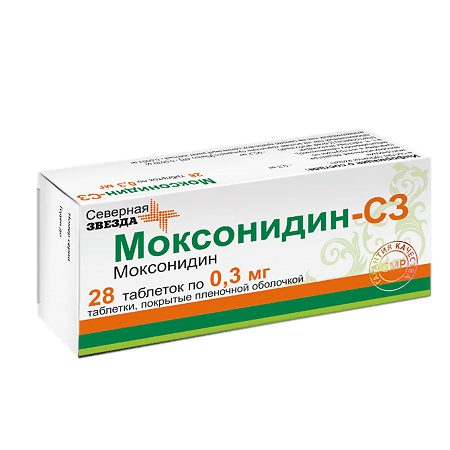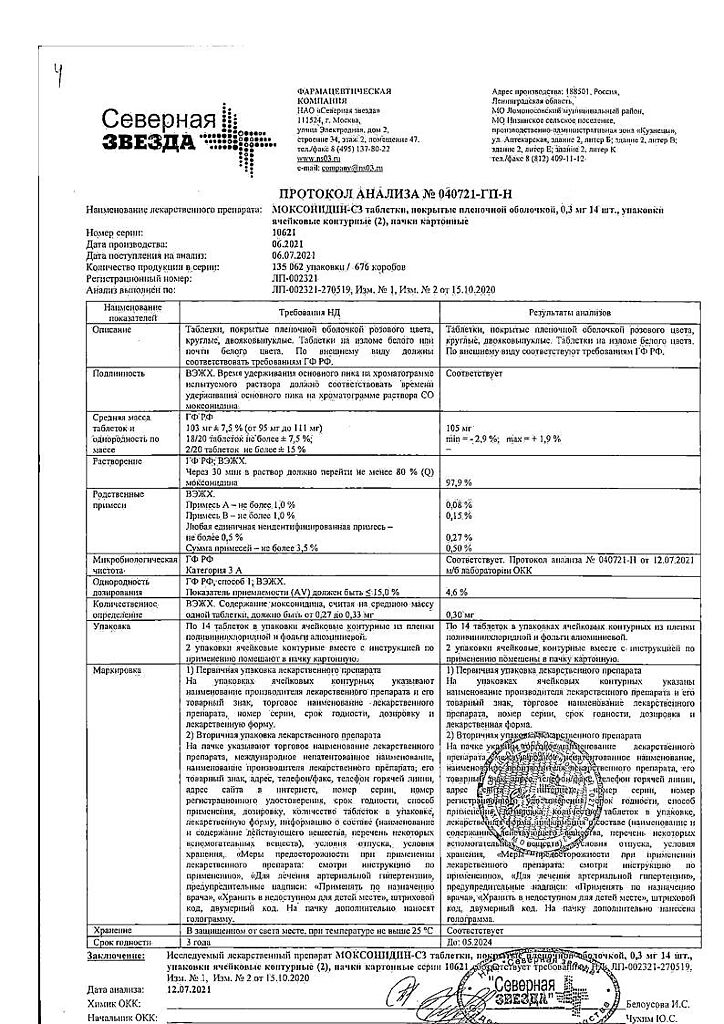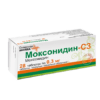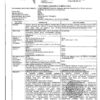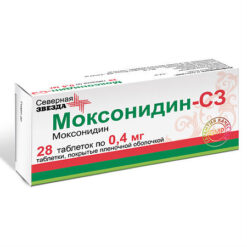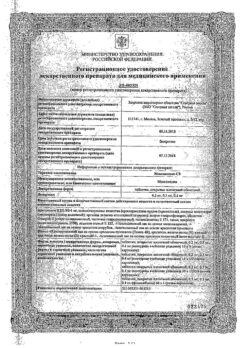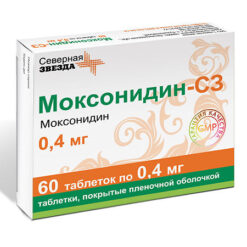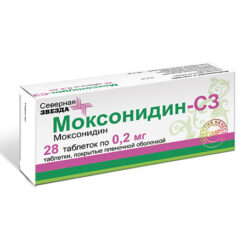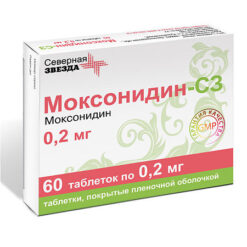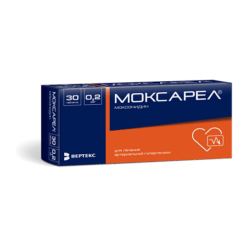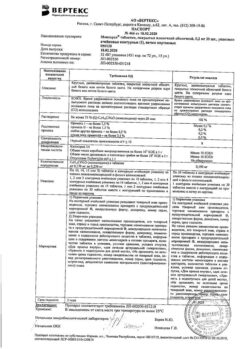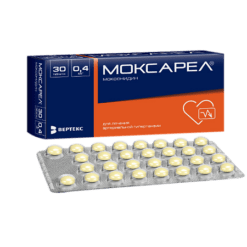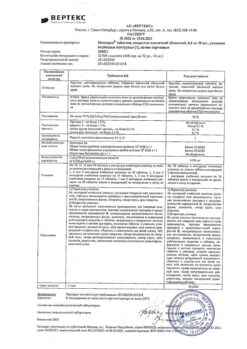No products in the cart.
Moxonidine-SZ, 0.3 mg 28 pcs.
€4.32 €3.84
Description
Pharmacotherapeutic drug group:
Hypotensive drug of central action.
ATC code: [C02AC05]
Pharmacodynamics
Moxonidine is a hypotensive drug with a central mechanism of action. In brain stem structures (rostral layer of lateral ventricles) moxonidine selectively stimulates imidazoline-sensitive receptors involved in tonic and reflex regulation of the sympathetic nervous system. Stimulation of imidazoline receptors reduces peripheral sympathetic activity and blood pressure (BP). Moxonidine differs from other sympatholytic hypotensive agents in its lower affinity for α2-adrenoreceptors, which explains the lower probability of developing sedative effects and dry mouth. Administration of moxonidine results in reduction of systemic vascular resistance and BP. Moxonidine improves insulin sensitivity index (compared to placebo) by 21 % in patients with obesity, insulin resistance and moderate arterial hypertension.
Pharmacokinetics
Intake:
After oral administration, moxonidine is rapidly and almost completely absorbed in the upper gastrointestinal tract. Absolute bioavailability is approximately 88%. Time of reaching maximum concentration is; about 1 hour. Food intake has no effect on the pharmacokinetics of the drug.
Distribution
The binding to plasma proteins is 7.2%.
Metabolism
The main metabolite is; dehydrated moxonidine. The pharmacodynamic activity of dehydrated moxonidine is; about 10% compared to moxonidine. Excretion The elimination half-life (T1/2) of moxonidine and the metabolite is 2.5 and 5 hours, respectively. Within 24 hours, over 90% of moxonidine is excreted by the kidneys (approximately 78% unchanged and 13% as dehydro-romoxonidine, other metabolites in the urine do not exceed 8% of the dose taken). Less than 1% of the dose is excreted through the intestine.
Pharmacokinetics in patients with arterial hypertension: Compared with healthy volunteers, patients with arterial hypertension show no changes in the pharmacokinetics of moxonidine.
Pharmacokinetics in the elderly
Clinically insignificant changes in the pharmacokinetic parameters of moxonidine have been observed in elderly patients, probably due to a decrease in its metabolic rate and/or slightly higher bioavailability.
Pharmacokinetics in children
Moxonidine is not recommended for use in patients younger than 18 years of age; therefore, no pharmacokinetic studies have been performed in this group. Pharmacokinetics in renal failure
The excretion of moxonidine is highly correlated with creatinine clearance (CK). In patients with moderate renal insufficiency (CK between 30-60 mL/min), equilibrium plasma concentrations and final T1/2 are approximately 2 and l.5 times higher than in patients with normal renal function (CK greater than 90 mL/min).
In patients with severe renal impairment (CKR less than 30 mL/min), equilibrium plasma concentrations and final T1/2 are 3 times higher than in patients with normal renal function. Administration of multiple doses of moxonidine results in predictable cumulation in patients with moderate to severe renal impairment.
In patients with terminal renal failure (KC less than 10 ml/min) on hemodialysis, equilibrium plasma concentrations and final T1/2 are 6 and 4 times higher, respectively, than in patients with normal renal function. In all groups, the maximum plasma concentration of moxonidine is 1.5 to 2 times higher. In patients with impaired renal function the dosage should be adjusted individually. Moxonidine is slightly excreted during hemodialysis.
Indications
Indications
Active ingredient
Active ingredient
Composition
Composition
Active substance:
moxonidine 0.3 mg
auxiliary substances (core):
croscarmellose sodium (primellose) 3.0 mg; lactose monohydrate (lactopress) (milk sugar) -; 95.2 mg; Colloidal silica (aerosil) -; 0.5 mg; sodium stearyl fumarate; 1.0 mg;
accompanied substances (coating):
Opadray II (polyvinyl alcohol, partially hydrolyzed -; 1.32 mg; E 171 titanium dioxide -; 0.6003 mg; talc -; 0.6 mg; macrogol (polyethylene glycol 3350) -; 0.3705 mg; soy lecithin E 322 -; 0.105 mg; aluminum varnish based on crimson dye [Ponceau 4R] -; 0.0039 mg; aluminum varnish based on sunset yellow dye 0.0003 mg).
How to take, the dosage
How to take, the dosage
Ingestion, regardless of meals. In most cases, the initial dose of the drug
Moxonidine is 0.2 mg per day. The maximum single dose is 0.4 mg. The maximum daily dose to be divided into 2 doses is 0.6 mg.
An individual adjustment of the daily dose is necessary depending on the patient’s tolerance to the ongoing therapy. No dose adjustment is required for patients with hepatic insufficiency.
The starting dose for patients with moderate to severe renal insufficiency is 0.2 mg/day. If necessary and if well tolerated, the daily dose may be increased to a maximum of 0.4 mg.
Interaction
Interaction
Special Instructions
Special Instructions
Contraindications
Contraindications
Cautions
Particular caution should be exercised when using moxonidine in patients with AV blockade of degree I (risk of bradycardia); severe coronary artery disease, severe CHD or unstable angina (insufficient experience of use), chronic heart failure, severe hepatic insufficiency, renal impairment (CK more than 30 ml/min).
Side effects
Side effects
Overdose
Overdose
There have been reports of several non-fatal overdoses when doses up to 19.6 mg were used at one time.
Symptoms: headache, sedation, excessive BP decrease, dizziness, asthenia, bradycardia, dry mouth, vomiting, increased fatigue, epigastric pain, respiratory depression and impaired consciousness. In addition, transient BP elevation, tachycardia, and hyperglycemia are also possible, as has been shown in several high-dose animal studies.
Treatment: there is no specific antidote. In cases of excessive BP decrease it may be necessary to restore the blood pressure by administration of fluids and dopamine (by injection). Bradycardia may be controlled with atropine (injection).
In severe cases of overdose, it is recommended to carefully control impaired consciousness and avoid respiratory depression. α-adrenoceptor antagonists may reduce or eliminate the paradoxical hypertensive effects of moxonidine overdose. Moxonidine is slightly excreted by hemodialysis.
Pregnancy use
Pregnancy use
Pregnancy
There are no clinical data on the use of Moxonidine in pregnant women.
In animal studies, embryotoxic effects of the drug have been established. Moxonidine should be administered to pregnant women only after careful assessment of the risk/benefit ratio, when the benefit to the mother exceeds the potential risk to the fetus.
Lactation period
Moxonidine penetrates into breast milk and therefore should not be administered while breastfeeding. If it is necessary to use Moxonidine during lactation, breastfeeding should be stopped.
Similarities
Similarities
Additional information
| Shelf life | 3 years |
|---|---|
| Conditions of storage | Store in a dry place protected from light at a temperature not exceeding 25 °С. Keep out of reach of children. |
| Manufacturer | North Star NAO, Russia |
| Medication form | pills |
| Brand | North Star NAO |
Other forms…
Related products
Buy Moxonidine-SZ, 0.3 mg 28 pcs. with delivery to USA, UK, Europe and over 120 other countries.

